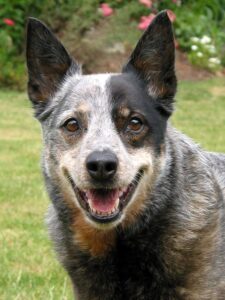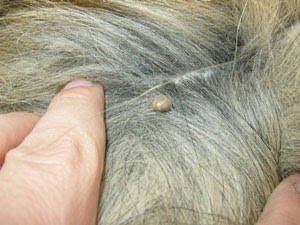HERDING DOGS
The herding dog group includes the Bearded Collie and Border Collies, Welsh Corgis, and German Shepherds. This category has the natural instinct to herd farm animals or round up different herds of animals including cattle, sheep, and goats. It is not unusual to find that when adopting a herding dog, the dog will attempt to herd the family kids as well—sometimes by even snapping at the kids’ legs as the family dog “rounds them up” to get the kids to move to a different location.
Many of us are familiar with German Shepherds and know that they are also called police dogs. Their protective nature, strength, and intelligence, makes this particular breed the breed of choice for K9 units.
Herding Dogs and Working Dogs eclipse each other’s categories because both can perform similar tasks. The difference is that the herding dog is better suited for farm and ranch herding of animals and cattle.
POPULAR HERDING BREEDS
Australian Cattle Dog
Average Height: 18-20 inches (male), 17-19 inches (female) Average Weight: 35-50 pounds
Life Expectancy: 12-16 years
 The compact but muscular Australian Cattle Dog, Also known as Blue Heeler or Queensland Heeler, the Australian Cattle Dog is related to Australia’s wild dog best known as the Dingo.
The compact but muscular Australian Cattle Dog, Also known as Blue Heeler or Queensland Heeler, the Australian Cattle Dog is related to Australia’s wild dog best known as the Dingo.
This muscular herder displays strength and agility. Puppies are born with a white coat that turns blue-gray or red and has distinctive mottling or specking. Australian Cattle Dogs are hard workers with inexhaustible energy and exceed at hunting, chasing, and, of course, herding livestock. Their boundless energy and supple gait make them excellent running partners.
This loyal breed is smart, alert, and watchful of strangers. They make great companions but need exercise and challenging activities to keep mentally and physically fit.
Australian Shepherd
Average Height: 20-23 inches (male), 18-21 inches (female) Average Weight: 50-65 pounds (male), 40-55 pounds (female)
Life Expectancy: 12-15 years
 Most information available about the Australian Shepherd points to its origin as being the United States. Wherever this wonder dog originated from, it is agreed that it played a huge role in the cowboy rodeo circuit being labeled the cowboy’s herding dog of choice.
Most information available about the Australian Shepherd points to its origin as being the United States. Wherever this wonder dog originated from, it is agreed that it played a huge role in the cowboy rodeo circuit being labeled the cowboy’s herding dog of choice.
Aussies, as they have become well know by this name, have a variety of different coats, including merle, a mottled pattern with different shades of red or blue). They are medium built but rugged and agile and have an overpowering impulse to herd, anything including your children. The Aussie may be best suited for a family that is familiar with this breed and not for a first-time pet parent with kids.
Border Collie
Average Height: 19-22 inches (male), 18-21 inches (female) Average Weight: 30-55 pounds
Life Expectancy: 12-15 years

This fast running, hardworking, herding dog is also best known for its incredible intelligence. A willing student of obedience training and a huge fan of agility, this dog is happiest as “a dog with a job” and does best with a pet parent that can provide stimulation mentally and physically. As with most highly intelligent breeds, training should begin early, and the pet parent needs to establish authority as well as leadership through appropriate training methods.
The Border Collie’s rough coat and the smooth coat come in a variety of colors and patterns. Though a wonderful, loving companion and family dog, the Border Collie can be aloof or unapproachable by strangers.
Pembroke Welsh Corgi
Average Height: 10-12.5 inches Average Weight: 30 pounds (male), 25-28 pounds (female)
Life Expectancy: 12-13 years
 According to the AKC, The Pembroke Welsh Corgi is one of the world’s most popular herding breeds. The Corgi is intelligent, trains easily and loves its human family. Though small in stature, they are muscular and strong and eagerly do a day’s work. They are long and low, but excellent cattle herders. Their courageous and spunky temperament makes them great watchdogs. Sporting red, sable, fawn, and black and tan coats that are thick and luxurious, with or without white markings, adds to their appeal as family dogs.
According to the AKC, The Pembroke Welsh Corgi is one of the world’s most popular herding breeds. The Corgi is intelligent, trains easily and loves its human family. Though small in stature, they are muscular and strong and eagerly do a day’s work. They are long and low, but excellent cattle herders. Their courageous and spunky temperament makes them great watchdogs. Sporting red, sable, fawn, and black and tan coats that are thick and luxurious, with or without white markings, adds to their appeal as family dogs.
Pembroke Corgis have a shorter tail or no tail and are lighter in weight than the Cardigan Welsh Corgi.
Well socialized, both breeds are wonderful members of the family and fond of children.
Shetland Sheepdog
Average Height: 13-16 inches Average Weight: 15-25 pounds
Life Expectancy: 12-14 years

The Shetland Sheepdog, also known as the Sheltie, is an extremely intelligent, quick, and obedient herder from Scotland’s remote and rugged Shetland Islands. Shetland Sheepdogs, more often called Shelties, look like a miniature version of their cousin, the Collie. They have a long, thick straight coat and dense undercoat. Their distinct look is black, blue merle, and sable with white markings.
They are easily trained and make excellent herding dogs but are also top-class competitors in obedience and agility.
They are attentive and affectionate family dogs but are a bit standoffish to those who are not familiar. Together with their strong bark, they are dependable watchdogs.
Collie
Average Height: 24-26 inches (male), 22-24 inches (female) Average Weight: 60-75 pounds (male), 50-65 pounds (female)
Life Expectancy: 12-14 years
 The stately looking Collie is one of the world’s most recognizable and well-loved breeds, made famous by the Television classic “Lassie” which ran from 1954-1974. The full-coated “rough” Collie is more familiar than the sleek “smooth” Collie.
The stately looking Collie is one of the world’s most recognizable and well-loved breeds, made famous by the Television classic “Lassie” which ran from 1954-1974. The full-coated “rough” Collie is more familiar than the sleek “smooth” Collie.
This large, fast, and athletic herding breed responds well to training and needs regular exercise. Collies are wonderful family dogs, as they are highly intelligent, loyal, adoring of children and crave companionship.
German Shepherd Dog
Average Height: 24-26 inches (male), 22-24 inches (female) Average Weight: 65-90 pounds (male), 50-70 pounds (female)
Life Expectancy: 7-10 years
 Though the German Shepherd Dog, is classified within the seven groups by the AKC, as a herding dog, the GSD is known best as a working dog because of its contribution to and superior performance as a working partner for police and military, to aid in rescue and tracking, as well as excellent guide dogs for the blind and physically challenged. Their unwavering courage and faithful devotion and loyalty make them superior family dogs as well as protectors. They are stoic and cautious when meeting and trusting new people. German Shepherds do well with other family dogs but may not be enthralled with those outside the household unless socialization and training begins at an early age.
Though the German Shepherd Dog, is classified within the seven groups by the AKC, as a herding dog, the GSD is known best as a working dog because of its contribution to and superior performance as a working partner for police and military, to aid in rescue and tracking, as well as excellent guide dogs for the blind and physically challenged. Their unwavering courage and faithful devotion and loyalty make them superior family dogs as well as protectors. They are stoic and cautious when meeting and trusting new people. German Shepherds do well with other family dogs but may not be enthralled with those outside the household unless socialization and training begins at an early age.





